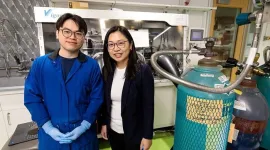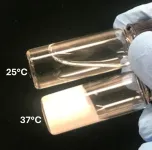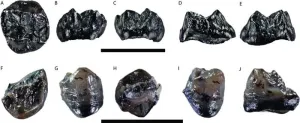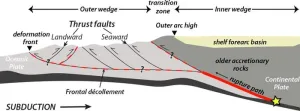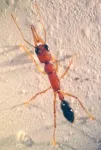(Press-News.org) As the electric vehicle market booms, the demand for lithium — the mineral required for lithium-ion batteries — has also soared. Global lithium production has more than tripled in the last decade. But current methods of extracting lithium from rock ores or brines are slow and come with high energy demands and environmental costs. They also require sources of lithium which are incredibly concentrated to begin with and are only found in a few countries.
Now, researchers at the University of Chicago Pritzker School of Molecular Engineering (PME) have optimized a new method for extracting lithium from more dilute — and widespread — sources of the mineral, including seawater, groundwater, and “flowback water” left behind from fracking and offshore oil drilling.
“Right now there is a gap between the demand for lithium and the production,” said Chong Liu, Neubauer Family Assistant Professor of Molecular Engineering and senior author of the new work, published in Nature Communications. “Our method allows the efficient extraction of the mineral from very dilute liquids, which can greatly broaden the potential sources of lithium.”
In the new research, Liu and her colleagues showed how certain particles of iron phosphate can most efficiently pull lithium out of dilute liquids. Their new findings could hasten an era of faster, greener lithium extraction.
Lithium at a cost
Today, most lithium used in lithium batteries comes from two basic extraction processes. Lithium rock ores can be mined, smashed up with heavy machinery, and then treated with acid to isolate the lithium. Lithium brine pools, on the other hand, use massive amounts of water pumped to the earth’s surface and then evaporated away — over the course of more than a year — to yield dried lithium.
“These methods aren’t particularly environmentally friendly to begin with, and if you start trying to work with less concentrated sources of lithium, they’re going to become even less efficient,” said Liu. “If you have a brine that is 10 times more dilute, you need 10 times more briny water to get the same amount of lithium.”
In recent years, Liu’s team has spearheaded a completely different method to get lithium out of dilute liquids. Their approach isolates lithium based on its electrochemical properties, using crystal lattices of olivine iron phosphate. Because of its size, charge and reactivity, lithium is drawn into the spaces in the olivine iron phosphate columns — like water being soaked into the holes in a sponge. But, if the column is designed perfectly, sodium ions, also present in briny liquids, are left out or enter the iron phosphate at a much lower level.
In the new work, Liu and her colleagues, including first author of the new paper Gangbin Yan, a PME graduate student, tested how variation in olivine iron phosphate particles impacted their ability to selectively isolate lithium over sodium.
“When you produce iron phosphate, you can get particles that are drastically different sizes and shapes,” explains Yan. “In order to figure out the best synthesis method, we need to know which of those particles are most efficient at selecting lithium over sodium.”
Not too big, not too small
The research team synthesized olivine iron phosphate particles using different methods, resulting in a range of particle sizes spanning 20 to 6,000 nanometers. Then, they divided those particles into groups based on their size and used them to build electrodes that could extract lithium from a weak solution.
When iron phosphate particles were too large or too small, they discovered, they tended to let more sodium into their structures. That led to less pure extractions of lithium.
“It turned out that there was this sweet spot in the middle where both the kinetics and the thermodynamics favor lithium over sodium,” said Liu.
The findings are vital to moving electrochemical lithium extraction toward commercial use. They suggest that researchers should focus on not just producing olivine iron phosphate, but producing olivine iron phosphate at the ideal particle size.
“We have to keep this desired particle size in mind as we pick synthesis methods to scale up,” Liu said. “But if we can do this, we think we can develop a method that reduces the environmental impact of lithium production and secures the lithium supply in this country.”
Other authors on the paper are Emory Apodaca, Suin Choi, Peter J. Eng, Joanne E. Stubbs, Yu Han, Siqi Zou, Mrinal K. Bera and Ronghui Wu of University of Chicago; Jialiang Wei and Wei Chen of Illinois Institute of Technology; and Evguenia Karapetrova and Hua Zhou of Argonne National Laboratory.
Citation: “Identifying critical features of iron phosphate particle for lithium preference,” Yan et al, Nature Communications, June 7, 2024. DOI: 10.1038/s41467-024-49191-3
Funding: This work was supported by the National Science Foundation and the Department of Energy Office of Science.
END
Research details method to get efficient, environmentally friendly lithium
UChicago Pritzker School of Molecular Engineering Asst. Prof. Chong Liu discovered the ideal particles for efficiently isolating lithium from seawater, ground water, or other dilute sources of the mineral
2024-06-07
ELSE PRESS RELEASES FROM THIS DATE:
In new experiment, scientists record Earth’s radio waves from the moon
2024-06-07
On Feb. 22, a lunar lander named Odysseus touched down near the Moon’s South Pole and popped out four antennas to record radio waves around the surface—a moment University of Colorado Boulder astrophysicist Jack Burns hails as the “dawn of radio astronomy from the Moon.”
It was a major achievement for the tenacious lander, which was built by the Houston-based company Intuitive Machines and had to overcome a series of technical difficulties to make it to the lunar surface. Burns is co-investigator on the radio experiment that flew aboard Odysseus called Radio wave Observations at the Lunar Surface ...
Restoring our ubiquitination machinery to overcome resistance to cancer therapy
2024-06-07
“[...] the identification of ubiquitin-conjugating enzymes like UBE2J1 and the innovative deployment of PROTAC-type androgen receptor degraders are crucial in combating prostate cancer and overcoming therapeutic resistance.”
BUFFALO, NY- June 7, 2024 – A new editorial paper was published in Oncoscience (Volume 11) on May 6, 2024, entitled, “Restoring our ubiquitination machinery to overcome resistance in cancer therapy.”
In this new editorial, researchers Xiaoling Li and Ping Mu from ...
Sky’s the limit for biofuels
2024-06-07
The United States has enough biomass potential to produce 35 billion gallons per year of aviation biofuel by 2050, a new report confirms.
Oak Ridge National Laboratory’s John Field provided biomass feedstock production expertise to the report focused on the role of the bioeconomy in U.S. decarbonization strategies, which was produced by the Department of Energy’s DECARB program.
The report examined the role of biomass in reducing greenhouse gas emissions across the economy, including opportunities to reach negative emissions. It includes data ...
Nirmatrelvir-ritonavir and symptoms in adults with postacute sequelae of SARS-CoV-2 infection
2024-06-07
About The Study: The results of this randomized clinical trial showed that a 15-day course of nirmatrelvir-ritonavir in a population of patients with postacute sequelae of SARS-CoV-2 infection (PASC) was generally safe but did not demonstrate a significant benefit for improving select PASC symptoms in a mostly vaccinated cohort with protracted symptom duration. Further studies are needed to determine the role of antivirals in the treatment of PASC.
Corresponding Author: To contact the corresponding authors, email Linda N. Geng, M.D., Ph.D. (geng@stanford.edu) and Upinder Singh, M.D. (usingh@stanford.edu).
To ...
Stanford Medicine trial:15-day Paxlovid regimen safe but adds no clear long-COVID benefit
2024-06-07
In a clinical trial conducted by Stanford Medicine investigators and their colleagues, a 15-day course of Paxlovid — an antiviral drug combination targeting SARS-CoV-2, the virus that causes COVID-19 — proved safe as an extended-duration treatment but didn’t lessen select symptoms of the syndrome known as long COVID: the persistence, or reappearance, of COVID-related symptoms three months or more after an initial COVID-19 infection.
The findings are described in a paper to be published ...
Antioxidant gel preserves islet function after pancreas removal
2024-06-07
Northwestern University researchers have developed a new antioxidant biomaterial that someday could provide much-needed relief to people living with chronic pancreatitis.
The study will be published on June 7 in the journal Science Advances.
Before surgeons remove the pancreas from patients with severe, painful chronic pancreatitis, they first harvest insulin-producing tissue clusters, called islets, and transplant them into the vasculature of the liver. The goal of the transplant is to preserve a patient’s ability to control their own blood-glucose levels without insulin injections.
Unfortunately, the ...
Tiny new species of great ape lived in Germany 11 million years ago
2024-06-07
Ancient apes in Germany co-existed by partitioning resources in their environment, according to a study published June 7, 2024 in the open-access journal PLOS ONE by Madelaine Böhme of Eberhard Karls University of Tübingen, Germany and David R. Begun, of University of Toronto, Canada and colleagues.
The Hammerschmiede fossil site in Bavaria, Germany is best known for exceptional remains of the ancient great ape Danuvius dating to the late Miocene Epoch, 11.6 million years ago. Other experts contest the strength of the evidence to support whether Danuvius is a hominid or whether ...
Cascadia Subduction Zone, one of Earth’s top hazards, comes into sharper focus
2024-06-07
Off the coasts of southern British Columbia, Washington, Oregon and northern California lies a 600 mile-long strip where the Pacific Ocean floor is slowly diving eastward under North America. This area, called the Cascadia Subduction Zone, hosts a megathrust fault, a place where tectonic plates move against each other in a highly dangerous way. The plates can periodically lock up and build stress over wide areas―eventually to be released when they finally lurch against each other. The result: the world’s greatest earthquakes, shaking both seabed and land, and generating tsunamis 100 feet high or more. Such a fault ...
Unlocking another piece of the Parkinson’s puzzle – scientists reveal workings of vital molecular switch
2024-06-07
Scientists at the University of Dundee have uncovered the inner relay of a molecular switch that protects the brain against the development of Parkinson’s disease.
The research provides new potential strategies to develop drugs that may benefit patients with Parkinson’s.
Parkinson’s is the fastest growing brain disorder in the world, however, there are currently no treatments that can slow or arrest the condition.
Previous research conducted at the University had found a gene called PINK1 is central to protecting brain cells against stress. In patients ...
A protein that enables smell—and stops cell death
2024-06-07
While smell plays a considerable role in the social interactions of humans—for instance, signaling fear or generating closeness—for ants, it is vitally important. Researchers from New York University and the University of Florida found that a key protein named Orco, essential for the function of olfactory cells, is also critical for the cells’ survival in ants.
Their study showed that mutating the orco gene in Harpegnathos saltator jumping ants dramatically decreased the number of olfactory neurons, suggesting that Orco is necessary for the development and life of these cells. The findings, published in Science Advances, offer insights into the cellular ...
LAST 30 PRESS RELEASES:
Minimum wage increases are linked to safer pregnancies
Left in the cold: Study finds most renters shut out of energy-saving upgrades
This crystal sings back: Illinois collaboration sheds light on magnetochiral instability
Organisms in the Atacama Desert soil are remarkably diverse
Children’s Hospital Colorado research outlines first pediatric classifications for suicide risk in adolescents and kids
No thyme wasted: Harnessing the medicinal benefits of thyme extract With small doses
Fat surrounding the colon interacts with the immune system
Genetic predisposition to excess body weight and survival in women diagnosed with breast cancer
New mechanism links Epstein-Barr virus to MS
Genetic risk factor and viral infection jointly contribute to MS
When a virus releases the immune brake: New evidence on the onset of multiple sclerosis
Wyss Institute-led collaboration awarded by ARPA-H PRINT program to engineer off-the-shelf, universal, transplant-ready graft for liver failure
Research on the behavioral mechanisms of rural distributed photovoltaic development: A view of prosumer perspective
More surgical patients are on opioid use disorder medications — hospitals must modernize pain care
New study reveals strategic logic behind global patent litigation venue selection
An abnormally slow heart rate is associated with xylazine-fentanyl overdose; primarily seen in northeastern United States
The path to solar weather forecasts
Inflammation and mitochondrial dysfunction in cirrhotic cardiomyopathy: therapeutic implications
The Great Bear Rainforest nature writing retreat
Research reveals hidden diversity of E. coli driving diabetic foot infections
Breakthrough in parallel Cartesian grid generation: Dynamic partition weight strategy resolves load imbalance
ESMT Berlin study shows how startups can communicate to win over silent audiences online
Design and optimization of wide-speed double swept waverider based on curved-cone projection method
Giant Magellan Telescope names Daniel T. Jaffe as president
New parameterization method for cislunar space cataloging enhances orbital awareness in Earth-Moon system
A “nu” way to measure researcher impact
Dark matter may have begun much hotter than scientists thought
Board games boost young kids’ math skills, UO research review shows
Unleashing floods: Researchers learn more about how fossils form
An open-source robotic system to perform cell culture tasks
[Press-News.org] Research details method to get efficient, environmentally friendly lithiumUChicago Pritzker School of Molecular Engineering Asst. Prof. Chong Liu discovered the ideal particles for efficiently isolating lithium from seawater, ground water, or other dilute sources of the mineral
